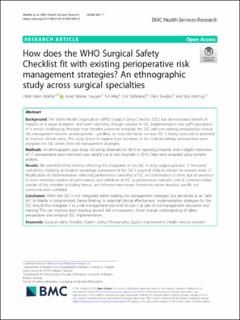| dc.contributor.author | Wæhle, Hilde Valen | |
| dc.contributor.author | Haugen, Arvid Steinar | |
| dc.contributor.author | Wiig, Siri | |
| dc.contributor.author | Softeland, Eirik | |
| dc.contributor.author | Sevdalis, Nick | |
| dc.contributor.author | Harthug, Stig | |
| dc.date.accessioned | 2021-03-10T11:48:20Z | |
| dc.date.available | 2021-03-10T11:48:20Z | |
| dc.date.created | 2020-02-13T08:51:29Z | |
| dc.date.issued | 2020 | |
| dc.identifier.issn | 1472-6963 | |
| dc.identifier.uri | https://hdl.handle.net/11250/2732602 | |
| dc.description.abstract | Background
The World Health Organization (WHO) Surgical Safety Checklist (SSC) has demonstrated beneficial impacts on a range of patient- and team outcomes, though variation in SSC implementation and staffʼs perception of it remain challenging. Precisely how frontline personnel integrate the SSC with pre-existing perioperative clinical risk management remains underexplored – yet likely an impactful factor on how SSC is being used and its potential to improve clinical safety. This study aimed to explore how members of the multidisciplinary perioperative team integrate the SSC within their risk management strategies.
Methods
An ethnographic case study including observations (40 h) in operating theatres and in-depth interviews of 17 perioperative team members was carried out at two hospitals in 2016. Data were analysed using content analysis.
Results
We identified three themes reflecting the integration of the SSC in daily surgical practice: 1) Perceived usefullness; implying an intuitive advantage assessment of the SSCʼs practical utility in relation to relevant work; 2) Modification of implementation; reflecting performance variability of SSC on confirmation of items due to precence of team members; barriers of performance; and definition of SSC as performance indicator, and 3) Communication outside of the checklist; including formal- and informal micro-team formations where detailed, specific risk communication unfolded.
Conclusion
When the SSC is not integrated within existing risk management strategies, but perceived as an “add on”, its fidelity is compromised, hence limiting its potential clinical effectiveness. Implementation strategies for the SSC should thus integrate it as a risk-management tool and include it as part of risk-management education and training. This can improve team learning around risk comunication, foster mutual understanding of safety perspectives and enhance SSC implementation. | en_US |
| dc.language.iso | eng | en_US |
| dc.publisher | BMC | en_US |
| dc.rights | Navngivelse 4.0 Internasjonal | * |
| dc.rights.uri | http://creativecommons.org/licenses/by/4.0/deed.no | * |
| dc.title | How does the WHO Surgical Safety Checklist fit with existing perioperative risk management strategies? An ethnographic study across surgical specialties | en_US |
| dc.type | Journal article | en_US |
| dc.type | Peer reviewed | en_US |
| dc.description.version | publishedVersion | en_US |
| dc.rights.holder | Copyright The Author(s). 2020 | en_US |
| dc.source.articlenumber | 111 | en_US |
| cristin.ispublished | true | |
| cristin.fulltext | original | |
| cristin.qualitycode | 2 | |
| dc.identifier.doi | https://doi.org/10.1186/s12913-020-4965-5 | |
| dc.identifier.cristin | 1793718 | |
| dc.source.journal | BMC Health Services Research | en_US |
| dc.source.40 | 20 | |
| dc.source.14 | 11 | |
| dc.relation.project | Universitetet i Stavanger: 5091 | en_US |
| dc.identifier.citation | BMC Health Services Research. 2020, 20, 111. | en_US |
| dc.source.volume | 20 | en_US |

